The Qualcomm Snapdragon 820 Performance Preview: Meet Kryo
by Ryan Smith & Andrei Frumusanu on December 10, 2015 11:00 AM EST- Posted in
- SoCs
- Snapdragon
- Qualcomm
- Snapdragon 820
GPU Performance
Shifting gears, let’s take a look at GPU performance. As we mentioned earlier, Qualcomm isn’t disclosing much about this GPU other than that it packs quite a bit more computational power than its predecessor and should be quite a bit faster in the process. This points to a potentially significant architectural shift, but that determination will have to wait for another time.
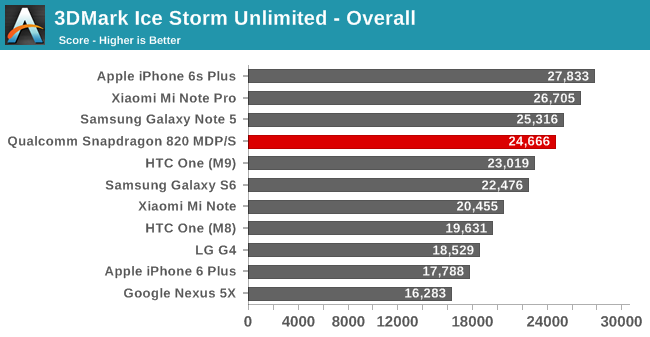
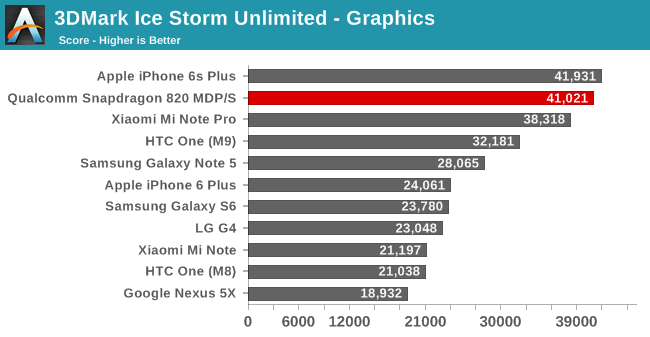
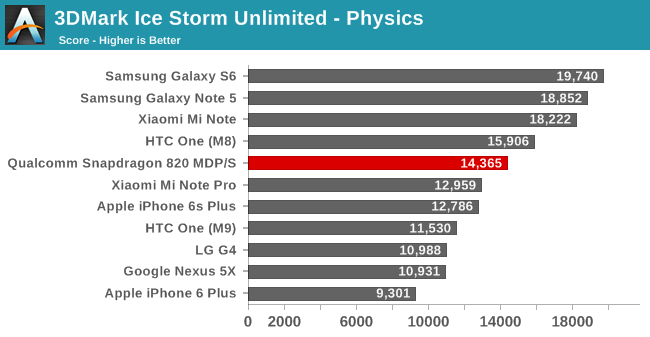
Starting with 3DMark Ice Storm Unlimited, the performance honestly doesn’t start out great. The overall score is significantly influenced by the physics score, which in turn is more concerned with the number of cores and their throughput on simple code than the ability to extract complex IPC. As a result the 4 CPU core 820 simply can’t catch up with the likes of the Samsung devices and their high-clocked big.LITTLE configurations. On the other hand the graphics score makes this the fastest Android phone to date, though relative to the 810 Mi Note Pro, perhaps not by a ton. Ultimately as this is an OpenGL ES 2.x test it’s not the most strenuous of tests these days, and comments from Qualcomm indicate that it may be a CPU-limited test on 820.
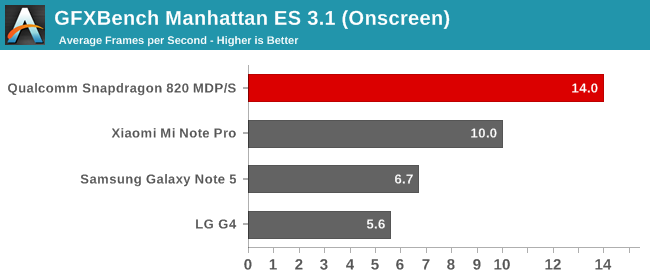
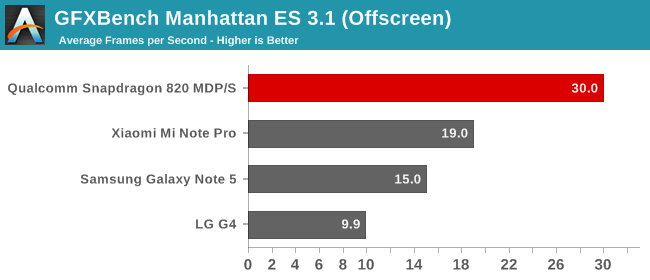
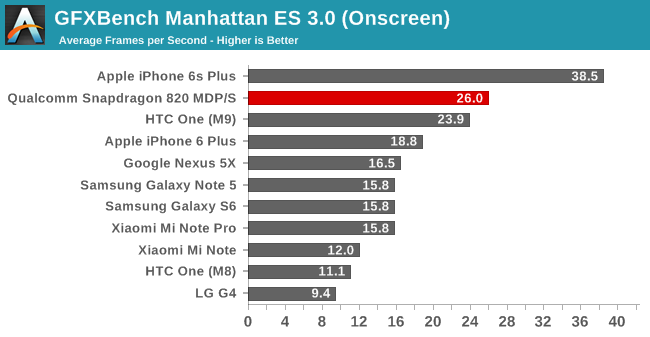
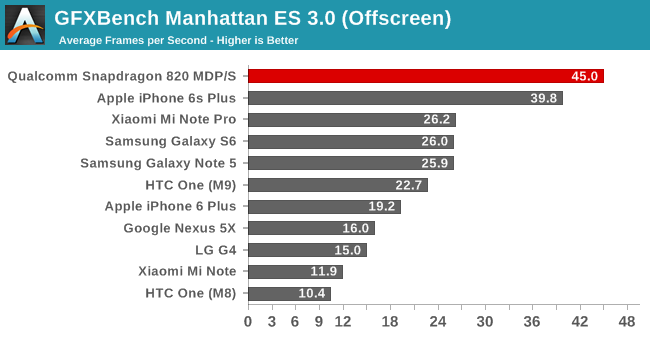
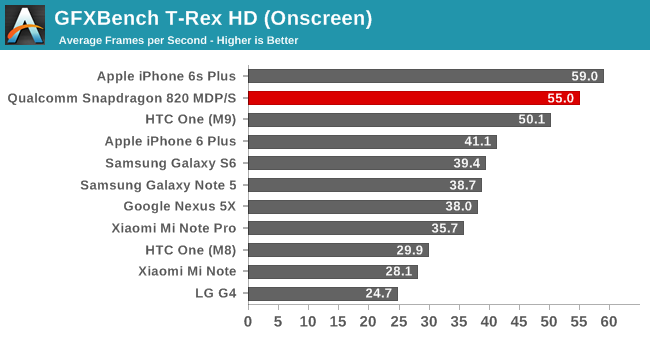
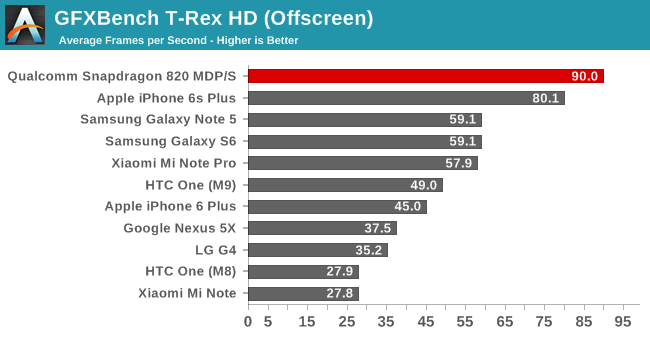
GFXBench on the other hand shows some massive gains for the 820 relative to any other Android device. In offscreen rendering mode, all 3 game tests – Manhattan ES 3.1, Manhattan ES 3.0, and T-Rex HD – put the 820 MDP/S as being 52% (or more) faster than the next-fastest Android device, either the 810 based Mi Note Pro or the Exynos 7420 based Samsung Galaxy Note 5. The single biggest jump we see is with Manhattan ES 3.0 at 72%, while the ES 3.1 version dials that back down to 52%. Even the iPhone 6s Plus, well known for its powerful GPU, is handily and consistently surpassed by the 820 here. Only due to the 6s Plus’s lower rendering resolution of 2208x1242 does it surpass the MDP/S in onscreen tests, as the latter needs to render at 2560x1600 (~50% more pixels). Qualcomm was aiming for some big GPU performance gains here and so far they are delivering.

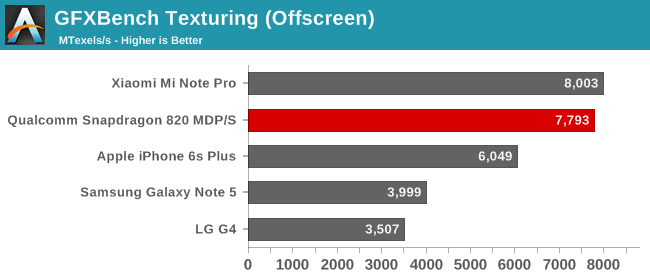
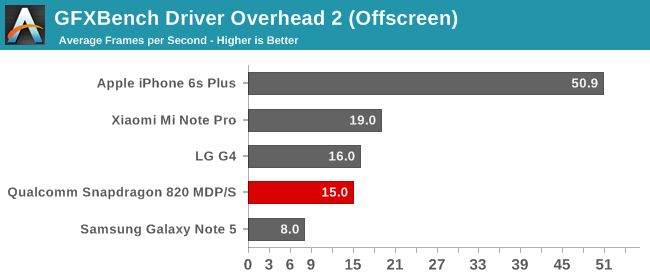
Curiously, GFXBench’s synthetic feature tests don’t show the same gains. Offscreen ALU performance is only slightly improved over the 810 (10%) or in the case of texturing is an outright regression. None-the-less full gaming performance is clearly in the 820’s favor. I’ve long suspected that the Adreno 430 GPU in the 810 had some kind of architectural bottleneck – perhaps an ALU/texture array that was difficult to fully utilize – and what we’re seeing here would back up that claim, as if that was the case then correcting it would have allowed Qualcomm to significantly boost their rendering performance while only barely changing their synthetic performance. Otherwise I find it a bit surprising that the driver overhead score is a bit worse on 820 than 810, which may be a result of the immature GPU drivers on this early device.










146 Comments
View All Comments
StrangerGuy - Friday, December 11, 2015 - link
A Helio X10 SoC found on phones <$200 is already massively overkill for the general user, Android inefficiencies or not.Last time I checked $600+ devices had a laughingly tiny 5% share in total Android sales last quarter and that of course is something Qualcomm would not mention in their marketing. The truth is hardly anybody cares about high-end SoCs outside synthetic benchmark whores that roams tech review sites.
Mondozai - Saturday, December 12, 2015 - link
Apple has 13-14% market share and they only do premium devices. You adf the Android space and you get close to 20% of TAM.You're ignorant.
Constructor - Saturday, December 12, 2015 - link
What you're describing together with the fact of Apple's double-digit total market share is actually a symptom of the fact that Android has almost completely lost the high end of the market to Apple (which is reflected by Apple raking in almost all the profits in the industry).Which of course is a major problem for Qualcomm: Android devices are not selling at prices comparable to Apple's, meaning that even the high-end Android devices are usually sold at steep discounts which in turn puts major price pressure on the device makers to fight for low component prices. which then effectively caps Qualcomm's pricing range much lower than they probably need to finance their expensive CPU development while they're still trying to catch up to Apple.
babadivad - Thursday, December 10, 2015 - link
Sounds like a 64bit Krait CPULochheart - Friday, December 11, 2015 - link
Don't forget that Apple has already 3 generations of 64bit Soc. This is the first from Qualcomm (in terms of custom ARM).melgross - Thursday, December 10, 2015 - link
I don't think it's fair to blame the processes. Apple ran on the same processes, and didn't have any problems. The problem was in the design of the chip. Let's just get that out there, instead of throwing blame elsewhere.xboxfanj - Friday, December 11, 2015 - link
Ryan, there is a compiler that accepts Kryo as a target (Qualcomm's LLVM/Clang fork)https://developer.qualcomm.com/download/snapdragon...
Babar Javied - Friday, December 11, 2015 - link
Last page (closing Thoughts), second paragraph, last line. "not a full-size tablet has was the case in the past couple of generations" I think you meant to say "as" not "has".V900 - Friday, December 11, 2015 - link
It's hard to be wildly optimistic with how the 820 will perform out in the wild next year.Let's not forget, that everything looked swell with the 810, when Anandtech tested the MDP for that SOC.
http://slatedroid.info/2015/02/anandtech’s-snapdragon-810-preview-no-overheating-issues-spotted/
phoenix_rizzen - Monday, December 21, 2015 - link
Don't forget that the S810 MDP was a tablet form factor, with all the extra cooling and battery and what-not that comes with it, while all the phones using the S810 are in the sub-6" category. Big difference!The S820 MDP is a phablet form factor, so it should be closer to the reality of using an S820 SoC in a sub-6" phone.